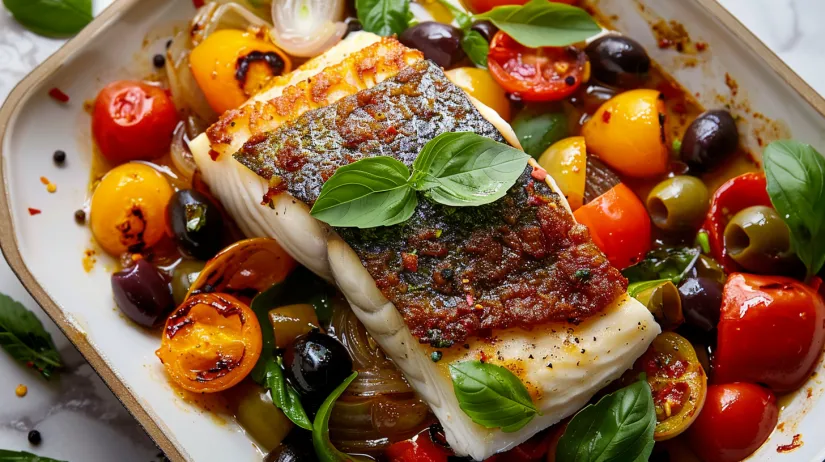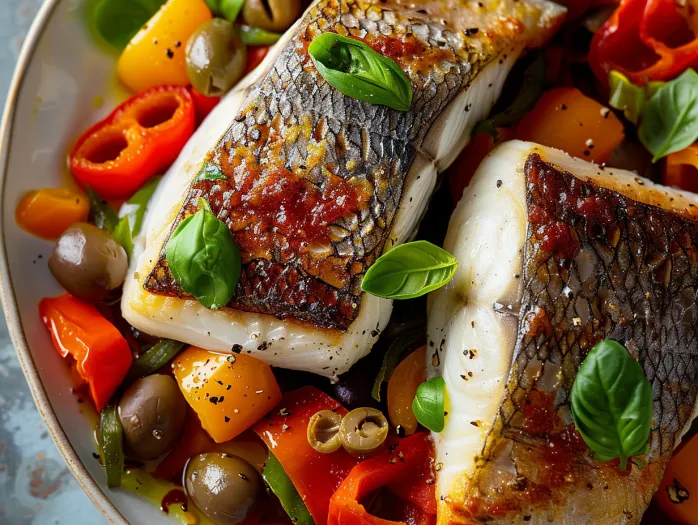 Pin
Pin
Buttery Chilean sea bass with crispy skin, blistered cherry tomatoes, and plump Castelvetrano olives is the kind of rich summer dinner that feels both special and easy. This dish highlights the freshness of the fish and lets each component shine. Basil and lemon tie everything together with a bright finish that makes you want another bite.
I first tried this after buying my first real piece of Chilean sea bass and it became my favorite way to enjoy fish at home without fuss.
Ingredients
- Chilean sea bass: choose skin-on for crispy skin and buttery texture look for thick filets that are firm and smell clean
- Extra virgin olive oil: adds richness and helps create a golden skin choose a grassy or peppery oil if possible
- Butter: deepens the sauce with nutty flavor use unsalted for better control of seasoning
- Shallot: brings gentle onion flavor without overpowering the fish use firm bulbs with tight skins
- Garlic: gives depth and aroma fresh cloves work best slice or mince to avoid burning
- Cherry tomatoes: add juiciness and sweetness choose ripe smooth fruit for the best flavor
- Castelvetrano olives: provide briny bite with a buttery edge look for green glossy olives already pitted
- Lemon juice: brightens the whole dish go for juicy lemons that feel heavy for their size
- Basil leaves: add freshness and color tear them gently to release the oils
- Crushed red pepper: provides gentle heat add more or less to taste
- Salt and pepper: necessary for seasoning use flakes or freshly ground for best results
Step-by-Step Instructions
- Prep the Fish
- Pat the sea bass filets very dry with paper towels and sprinkle both sides with salt and pepper. This draws out moisture and sets up the skin for crispiness. If your filets are uneven, slice them as needed so each piece is about the same size and thickness.
- Sear the Fish
- Heat olive oil in a wide skillet over medium-high until it shimmers. Place the fish skin-side down in the skillet, gently pressing the filets with a metal spatula. Do not move the fish as it cooks. Cook for five to seven minutes or until the skin releases easily and is golden crisp. Slide the spatula underneath and flip the fish. Reduce the heat to medium and cook five to seven minutes more until just cooked through and the internal temperature hits 145 degrees Fahrenheit.
- Rest the Fish
- Transfer the cooked fish to a plate and tent loosely with foil. Resting gives the juices time to settle so the fish stays buttery and tender.
- Build the Tomato Olive Mixture
- Return your skillet to medium heat and melt the butter. Add the diced shallot and minced garlic. Stir constantly for about one minute just until fragrant and softened. Add the cherry tomatoes and olive halves. Stir frequently for five minutes so the tomatoes blister and their skins split. Crush a few tomatoes gently with a spoon to let their juices form a fresh sauce.
- Finish with Lemon and Basil
- Pour in the lemon juice and scatter the torn basil leaves into the skillet. Let everything sizzle for one minute. Taste and adjust with salt pepper and a pinch of crushed red pepper for gentle heat. Turn off the heat.
- Serve
- Arrange your rested fish on a serving platter. Spoon the tomato and olive mixture around the filets. Scatter more fresh basil on top and serve while hot.
 Pin
Pin
Chilean sea bass is my favorite because of its melt-in-your-mouth texture. I still remember my family begging for seconds the first time I made this. The mix of warm tomatoes olives and basil is so cozy even picky eaters get hooked.
Storage Tips
Leftover sea bass can be kept in the fridge up to two days tightly covered. To reheat set the oven to low heat and gently warm the fish covered so it does not dry out. The tomato and olive mixture can be stored separately and gently rewarmed on the stove.
Ingredient Substitutions
If Chilean sea bass is not available use another thick white fish like cod halibut or black bass. Castelvetrano olives can be swapped for any meaty green olive just make sure they are pitted. Shallot can be swapped for mild yellow onion in a pinch.
 Pin
Pin
Serving Suggestions
Serve this fish with a side of warm crusty bread to soak up the juices or over a simple orzo pasta for a more filling meal. Pair with a crisp white wine or lemony sparkling water for a refreshing touch.
Cultural and Historical Context
Chilean sea bass originally called Patagonian toothfish was rebranded to appeal to more home cooks and it quickly became a restaurant favorite for its buttery richness. This kind of simple skillet preparation is popular along southern European coasts like Italy and Spain where seafood fresh vegetables and herbs are star players.
Frequently Asked Questions About the Recipe
- → How do you ensure sea bass skin turns crispy?
Pat the fish completely dry and season well. Cook skin-side down in hot oil without moving it until the skin easily releases from the pan, pressing gently for even contact.
- → Which olives work best for this preparation?
Castelvetrano olives offer a mild, buttery flavor and bright color, but other green or mixed olives can be used for varied saltiness and texture.
- → What is the ideal internal temperature for cooked sea bass?
Sea bass should be cooked to an internal temperature of 145°F. Check with a thermometer for best results.
- → Can I substitute another fish if sea bass isn’t available?
Yes, try other meaty white fish such as cod, halibut, or grouper. Adjust cooking time based on thickness.
- → What’s the best way to serve this dish?
Arrange the fish on a platter and surround it with the tomato and olive mixture. Finish with extra basil and a squeeze of lemon.
